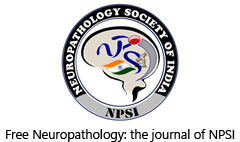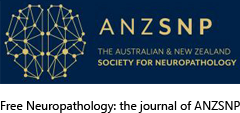Opinion Pieces


The World Health Organization classification of pituitary tumors provides a framework for pathologists and researchers to classify pituitary adenomas. From the perspective of a practicing pathologist, this classification can be improved by pooling immunohistochemical data in a more standardized way, and by deliberately distinguishing features that assist in classification from those that do not. This article illustrates one general workflow to examine classification features consisting of immunohistochemical stains for anterior pituitary tumors, in order to promote debate and advance an evidence-based framework for classification.

Confocal laser endomicroscopy (CLE) represents a new non-invasive in vivo imaging technique that holds considerable promise in neurosurgery and neuropathology. CLE is based on the principle of optical sectioning which uses pinholes placed in the light path to selectively image photons of a specific focal plane by filtering out photons above and below the focal plane. Potential indications of CLE in neurosurgery and neuropathology include intraoperative tumor diagnosis and staging as well as assessment of tumor resection margins notably in the case of diffusely infiltrating gliomas. CLE-based tumor analysis in near-real time may also have a significant impact on future tumor resection strategies. We here discuss the technical features of CLE, its potential for wide-field imaging, its role in comparison to established histological techniques for intraoperative tumor assessment and its position in digital pathology and telepathology. Based on our group’s experience with a commercially available confocal laser endomicroscope (ZEISS CONVIVO), we critically address the current state of intraoperative CLE in brain tumor surgery, the applicability of classical histological criteria and the strategies required to further improve the diagnostic accuracy of CLE. We finally discuss how a widespread use of CLE in neurosurgery may modify the role of neuropathologists in intraoperative consultation, generating both new opportunities and new challenges.

We present for consideration a hypothesis that impaired movement of lipoprotein particles in the extracellular space in the brain in ageing is central to and causes all the key pathophysiological features of Alzheimer’s disease (AD). The role of lipoprotein particles is to transport cholesterol from glial cells, where it is synthesised, to neurons, which require cholesterol for synaptic plasticity. The lipoprotein particles have a cholesterol-containing hydrophobic core, in which amyloid-β (Aβ) can be solubilised. The core is surrounded by a hydrophilic surface containing apolipoprotein E (APOE) which, as neurons bear receptors for APOE, determines the destination of the particles. The problem arises because the extracellular space is a narrow cleft, barely wider than the lipoprotein particles themselves, which they have to navigate in order to perform their crucial cholesterol-transporting function. We explain how lipoprotein particles could become trapped in the ageing extracellular matrix and that this primary abnormality results in reduced delivery of cholesterol to neurons leading to impaired synaptic plasticity, crucial for learning and memory. It can also explain extracellular Aβ accumulation, to which a microglial response generates a neurotoxic reaction, and intraneuronal tau aggregation, each of which exacerbate the problem. All these players have been known for many years to be important in Alzheimer’s pathogenesis but a single unifying mechanism to explain how they are linked has been lacking. This proposed mechanism, with entrapment of lipoproteins particles as key to the development of AD, can explain the failure of so many clinical trials and points out new directions to be taken.
The COVID-19 vaccines comprised of adenoviral vectors encoding the Spike (S) glycoprotein of SARS-CoV-2 are highly effective but associated with rare thrombotic complications. The adenovirus vector infects epithelial cells expressing the coxsackievirus and adenovirus receptor (CAR). The S glycoprotein expressed locally stimulates neutralizing antibody and cellular immune responses. These vaccines have been associated with thromboembolic events including cerebral venous sinus thrombosis (CVST). S glycoprotein stimulates the expression of cyclooxygenase-2 (COX-2) and leads to massive generation of thromboxane A2 in COVID-19. Megakaryocytes express CAR and we postulate that S glycoprotein stimulated generation of thromboxane A2 leads to megakaryocyte activation, biogenesis of activated platelets and thereby increased thrombogenicity. Cerebral vein sinuses express podoplanin, a natural ligand for CLEC2 receptors on platelets. Platelets traversing through the cerebral vein sinuses could be further activated by thromboxane A2-dependent podoplanin-CLEC2 signaling, leading to CVST. A prothrombotic hormonal milieu, and increased generation of thromboxane A2 and platelet activation in healthy females compared to males is consistent with increased risk for CVST observed in women. We propose that antiplatelet agents targeting thromboxane A2 receptor signaling such as low-dose aspirin merit consideration for chemoprophylaxis when administering the adenovirus based COVID-19 vaccines to young adults at risk of thrombosis provided there are no contraindications.
For the past 400 years, the most common cause of dementia was tertiary syphilis [1]. Its prevalence declined dramatically with the advent of potent antibiotics in the 20th century, but these same antibiotics also helped increase our average lifespan, leading to dramatic increases in the prevalence of age-related dementias. Abundant progress has been made connecting early onset dementias with mutations in neural genes. Late onset dementias have been linked to a more enigmatic set of genes, some of which have been connected to neuroinflammation, begging the question: Are age-related dementias linked to infection? Numerous studies have reported an association between dementia and infections in general and viral infections in particular. While these associations have been subject to extensive reviews, the purpose of this synthesis is to examine the hypothesized link of viral infections and dementia from the opposite perspective: What do we know about acute and chronic encephalitides that could forge a link with dementias? There appears to be little support for the concept that viral infections are a major contributor to today’s common dementias. However, the emergence of new central nervous system (CNS) viral infections, coupled with senescent immune and nervous systems in our aged population, create new opportunities for infections to contribute to dementia.

An accumulating body of literature has emerged in the past 25 years to show that Parkinson’s disease (PD) is not only a disorder of the brain but also of the gastrointestinal tract and more generally of the gut-brain axis. Gastrointestinal symptoms occur in almost every PD patient at some point and in nearly every case examined pathologically autopsy studies find alpha-synuclein deposits, the pathological hallmarks of PD, in the enteric nervous system. This concept of ‘enteric synucleinopathy’ led to the hypothesis that the enteric nervous system might play a pivotal role in the initiation and spreading of PD. Although this hypothesis opens up interesting perspectives on the pathogenesis of neurodegenerative disorders, some important questions are still pending. The present opinion paper describes and compares the physiological and pathophysiological properties of alpha-synuclein in the brain and the enteric nervous system. We conclude that the existing data supports the existence of pathological alpha-synuclein species in the gut in PD. We also discuss if gut-brain interactions are important in other neurodegenerative disorders.
SARS-CoV2 infection causes COVID-19, and represents the most emergent health care crisis of our generation. Ample evidence in the scientific literature suggests that SARS-CoV, MERS-CoV, and endemic human coronaviruses infect brain cells. We delineate a rationale for encouraging evaluation of the brain, and in particular the brainstem, in COVID-19 so that potential neuropathological mechanisms can be delineated.
The “neuroepithelial tumor”: Exchanging our trash can for an industrial size dumpster?

















